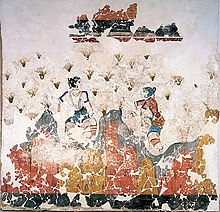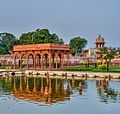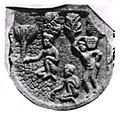The Gardening Portal

Gardening is the process of growing plants for their vegetables, fruits, flowers, herbs, and appearances within a designated space. Gardens fulfill a wide assortment of purposes, notably the production of aesthetically pleasing areas, medicines, cosmetics, dyes, foods, poisons, wildlife habitats, and saleable goods (see market gardening). People often partake in gardening for its therapeutic, health, educational, cultural, philosophical, environmental, and religious benefits. Gardening varies in scale from the 800 hectare Versailles gardens down to container gardens grown inside. Gardens take many forms, some only contain one type of plant while others involve a complex assortment of plants with no particular order. (Full article...)
Horticulture is the art and science of growing plants. This definition is seen in its etymology, which is derived from the Latin words hortus, which means "garden" and cultura which means "to cultivate". There are various divisions of horticulture because plants are grown for a variety of purposes. These divisions include, but are not limited to: gardening, plant production/propagation, arboriculture, landscaping, floriculture and turf maintenance. For each of these, there are various professions, aspects, tools used and associated challenges; Each requiring highly specialized skills and knowledge of the horticulturist. (Full article...)
General images -
Selected article -

Human cultivation and use of saffron spans more than 3,500 years and extends across cultures, continents, and civilizations. Saffron, a spice derived from the dried stigmas of the saffron crocus (Crocus sativus), has through history remained among the world's most costly substances. With its bitter taste, hay-like fragrance, and slight metallic notes, the apocarotenoid-rich saffron has been used as a seasoning, fragrance, dye, and medicine.
The wild precursor of domesticated saffron crocus was likely Crocus cartwrightianus, a plant native to mainland Greece, Euboea, Crete, Skyros and some islands of the Cyclades. This species has been used as a wild source of saffron. A study reported in 2019 that the authors considered that a cross between two cytotypes of Crocus cartwrightianus was responsible for the emergence of Crocus sativus. This was probably a unique or very rare event as there is no genetic diversity in commercial saffron today. Another study in 2019 showed that a population of Crocus cartwrightianus near Athens in Attica was the closest match to the theoretical ancestors of Crocus sativus. (Full article...)Selected image

Related portals
Did you know -
- ... that a cactus is named after Gertrude Webster, who helped found the Desert Botanical Garden in Arizona?
- ... that the Shakespeare garden in Wessington Springs, South Dakota, was the first of its kind in the state?
- ... that a proposed footbridge connecting the Asian Garden Mall to another Vietnamese-American shopping center met opposition because it was deemed "too Chinese"?
- ... that the New Zealand Geographic Board initially rejected the name of the Garden of Eden Ice Plateau for being biblical in origin?
- ... that the woodland garden, "colourfully planted with exotic shrubs and herbaceous plants, dominated English horticulture from 1910 to 1960"?
- ... that a guerrilla garden established atop an abandoned railroad in Long Island City became legally recognized by the MTA?
- ... that Ardwall House has a garden ornament in the form of an early mediaeval Pictish slab inscribed with a Celtic cross?
- ... that Vita Sackville-West described the garden rooms she created at Sissinghurst as "a series of escapes from the world, giving the impression of cumulative escape"?
Things you can do
- This list is transcluded from the tasks list page. To edit the list, click here
 |
Here are some tasks awaiting attention:
|
WikiProjects
Topics
Categories
Associated Wikimedia
The following Wikimedia Foundation sister projects provide more on this subject:
-
 Commons
Commons
Free media repository -
 Wikibooks
Wikibooks
Free textbooks and manuals -
 Wikidata
Wikidata
Free knowledge base -
 Wikinews
Wikinews
Free-content news -
 Wikiquote
Wikiquote
Collection of quotations -
 Wikisource
Wikisource
Free-content library -
 Wikiversity
Wikiversity
Free learning tools -
 Wiktionary
Wiktionary
Dictionary and thesaurus



























































































Recent Comments